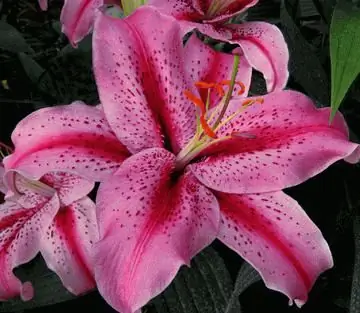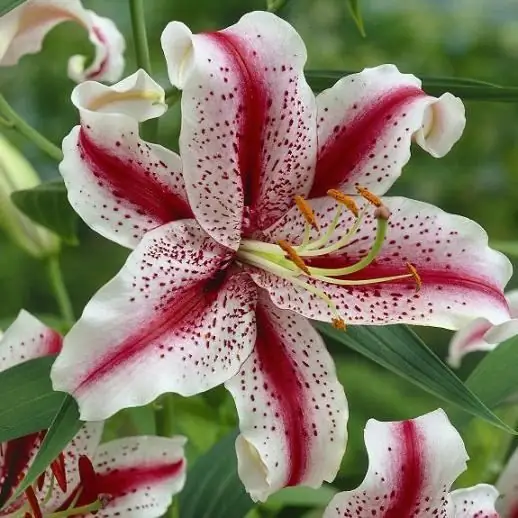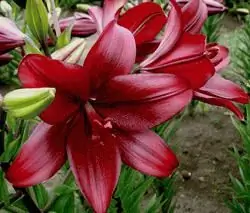Many flower growers are fanatical collectors of beautiful lilies, with several dozen different varieties. Bulbs bloom depending on the variety of the hybrid, the depth of planting, as well as the degree of illumination of the site. If you have a whole collection of different hybrids in your garden, the general flowering period of plantings starts from the end of June and continues until autumn itself, when the varieties bloom, replacing each other in turn. Let's learn more about planting and caring for such amazing flowers as lilies. Plant varieties and species are divided into 9 sections. We will also analyze the main mistakes of amateur gardeners and get acquainted with the new selection.

Varieties and Classification
Indeed, there is something to chase in an effort to find a novelty and brag about it to the neighbors, because the total varietal number of the plant reaches 3,000 different items. However, the general mass of flower growers does not remember well how the name of the varieties of lilies sounds, focusing on the color scheme and type (section). Moreover, some of the plantings roam from garden to garden, as they say, incognito, in exchange. Let's start with the classificationsections:
- Asian lilies (A) - the most unpretentious, and therefore common in our territories since time immemorial. They winter well, have small flowers of various shades, which open already in the first half of summer. Representatives of this variety do not smell, which indescribably pleases lovers of cut bouquets.
- Longiflorum lilies, longiflorums (LO) are the most odorous of all the presented sections.
- Oriental hybrids, or orientals (O), also with a persistent aroma. They are rightfully considered the most beautiful of all sections. Blooms from late August to September.
- Tubular lilies (T) - a popular section in the middle lane, with an almost suffocating pungent smell.
We have finished classifying sections, moving on to hybrids (crosses between sections), which are constantly replenishing new varieties of lilies (FROM hybrids and other successful breeding experiments). Some of them have mixed colors, for which they are most revered by flower growers, and also do not have such a pronounced pungent aroma. The smell of hybrid lily flowers has become more delicate.

Hybrid Sections
East Asian hybrids (OA) are considered the least numerous, this is due to the fact that scientists have not yet been able to derive a sufficient number of colors. The bulk of the presented section has bright orange-red flowers with a yellow or white border.
But OT hybrids, as well as LA hybrids, can be considered undoubted selection success, however, inthere are certain difficulties in growing and breeding these sections, which we will definitely talk about.
It should also be noted that the last, ninth section contains numerous wild-growing lilies.
How to grow hybrids correctly?
Year from year the quality of the hybrid material imported into our country is steadily increasing. Lily is getting more and more popular. Its varieties are becoming more and more beautiful, and caring for them is not as difficult as it might seem to an inexperienced florist. Why are some flora lovers in no hurry to breed hybrid, tubular or Asian varieties? Yes, all because, having planted such an onion once and failed, they decide for themselves that this occupation is definitely for the elite. One simple rule should be understood: planting planting material on a shovel bayonet in order to insure against freezing is a deep delusion. Only Asian varieties are planted so deeply, and OT hybrids of lilies, varieties of tubular and long-flowered representatives must be placed in the soil to a depth of 10-15 cm, as, however, indicated on the packages. In our minds, the thought of severe winter frosts is ineradicable.

What happens to a bulb when it is planted deep?
The answer to the question is almost obvious. With a deep laying of the bulb, the thermal regime during the growing season is violated, which weakens the plant and either slows down flowering, or completely eliminates this process. Imagine this picture: in the spring, a sprout needs to break through to the light, and heI spent all my strength to overcome a distance of 25 cm, or even deeper. Then the plant simply will not have the strength to bloom, and the lonely thin stalk of the shoot will stand restless all summer. So, the lily (grade) Royal and does require laying the bulb to a depth of 5-6 cm. Before planting, the rhizome of the lily is cut a little with a pruner. This will help nutrients from the soil to penetrate faster into the bulb and, accordingly, better develop it. Well, as expected, immediately after laying in the ground, the planting material is thoroughly shed.
Drop-off period
Modern OT hybrids of lilies (varieties Shocking, Robina, Dallas), as well as LA-, LO-, OA-hybrids can be planted both in autumn and in spring, in May, when the soil warms up quite well. Flowering of crops planted in spring can be expected already in the current season. Of course, you should not pin your hopes on getting a large number of flowers on a bush right away, but flower growers are impatient people. And they love it when the fruits (and in this case flowers) of their labor can be appreciated without postponing for future seasons.
When to stop watering?
After the Asian lily (varieties Aphrodite, Sphinx and others) stops flowering, it is necessary to cut the stem for the best maturation of the children and so that in subsequent flowering seasons the bush is formed from several strong shoots at once. This fully applies to other hybrids. Now watering can be stopped. If planting new varieties in the ground is planned for autumn, the bulb can not be watered, in order to avoid excessivesoil moisture and, as a result, an increase in the risk of freezing.

How to store hybrids in winter?
Most flower garden lovers purchase and plant oriental lilies (varieties of Betty, Allegro, Aurora, Africa, Imperial Gold and others) with the expectation that a perennial bulbous plant does not require constant replanting and storage in winter. However, in fact, these hybrids are very fond of dry winter storage. Simply put, the bulbs in the fall must be dug up and dried, and the rest of the stem removed. Then store, like gladioli, at a temperature of +1 to +5 degrees in a dark place (for example, in a refrigerator or in the cellar of a private house).
Dry shelter
Remember how we mentioned real collectors who have been growing dozens of hybrid varieties in their garden for years? What about those who have a crop of lilies comparable only to potatoes? In this case, you can use the so-called dry shelter, when a film is laid on the top layer of soil, then a thick layer of mulching material (sawdust, dry leaves, hay). And only then spruce legs are laid on the mulch, after that - again a layer of greenhouse film. Asian hybrids of lilies (Miss Ellis, Bars, Pixie, Black Thrush, Sorbet and others) will be especially happy with this method of shelter. Dry soil under a layer of mulch can be achieved if the film is laid on the surface above the bulb almost immediately after the end of the flowering period. For the moisture accumulated on the film during the period of prolonged autumn rains, there are row-spacing grooves. SoThus, the soil above the bulb remains dry and will not be able to freeze, even if the depth of laying the bulb is only 10 centimeters. Film, mulching material and spruce branches form additional protection for the plant. This method of shelter is able to protect lilies (we reviewed the varieties, description and general recommendations in this article) from return spring frosts.

Spring Care
In the spring, layers of film and mulch can be disposed of after the snow mass has melted. Do not allow the soil to rot in direct sunlight. However, from frosts and in order to speed up the appearance of the desired shoots, arcs are placed on the bed with lilies, on which dense covering material is placed. Such a shelter will allow you to keep warm, get quick shoots, and also allow the air inside the makeshift greenhouse to circulate freely.
Hybrid varieties are constantly updated
If we take into account modern breeding successes, then they can include a lily (varieties Star Klass, Siberia, Optimist) with increased frost resistance. The listed eastern hybrids are able to winter at all without the so-called dry shelter. Special attention should be paid to hybrids of the newest selection - LOO (oriental long-flowered). Large-flowered bulbs were crossed with long-flowered bulbs and got just giant "gramophones" reaching 40 cm in diameter. The most successful example is a white lily (Brilliant variety). For the winter, it requires a dry shelter with a thicker (up to 30cm) layer of mulch.

Why might Oriental hybrids not bloom next season?
Oriental lilies bloom last, already in autumn. It is worth delaying planting in the spring and planting the bulb, say, at the end of June, and the plant will bloom only in October. And if frosts come already with the onset of November, then the onion will not have time to recover. That is why it is necessary to monitor the timing of planting in accordance with the timing of flowering of a particular hybrid and count on a minimum rest period before the onset of cold weather. Such a “vacation” is necessary for the plant in order to gain strength before the next season, and in time it should last at least a month.
A little about pests
We have not listed all the factors that prevent bulbs from flowering. We have not mentioned the numerous pests that can simply destroy the splendor that has not bloomed at the root. During the summer, it is necessary to track ugly, clumsy, curved shoots with spots on the petals and isolate them in time. Freak shoots signal a viral disease that has affected either the soil or the bulb. By sacrificing one plant, you can secure the remaining specimens. The soil where the infected plant lived is best treated with a chemical composition specially provided against viral flower infections.
A disease such as bulb rot appears due to a lack of drainage system, stagnation of moisture at the rhizome, as well as the introduction of insufficiently rotted manure into the hole during planting.
Important! You can not plant lilies in the place where tulips used to livedue to the latter's great propensity for such a dangerous virus as variegation.

Conclusion
So, we learned that lily hybrids do not like to be planted at a decent depth, and also that plants prefer to winter under a “dry shelter”. We stated that for the central zone of Russia and the regions of the North, Asian hybrids are the most adapted to the conditions of existence. And we learned that new varieties of hybrids are constantly replenished.






